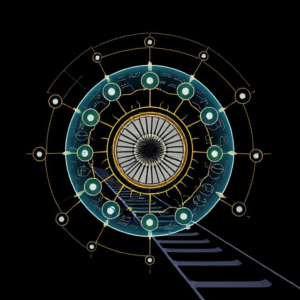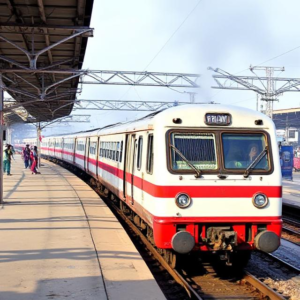Railway Innovation and Research: Indian Railways R&D Wing and Its Initiatives
Railway Innovation and Research are all about coming up with new ideas, technologies, and solutions that can improve the safety, efficiency, and performance of the railway system. The Indian Railways Research & Development (R&D) wing plays a crucial role in making the railway network smarter, faster, and more reliable. Let’s dive into how this works and what initiatives they are working on!

1. What is the Indian Railways Research & Development (R&D) Wing?
The R&D Wing of Indian Railways is a dedicated department focused on research, technology development, and innovation for improving the railway system. This department works on a variety of projects aimed at making the railways safer, more efficient, and more sustainable.
They also work on testing new train technologies, track maintenance systems, passenger safety features, and more.
2. Key Objectives of the R&D Wing:
- Innovation: Developing new technologies and systems for the Indian Railway network.
- Efficiency: Making the trains run on time, faster, and at a lower cost.
- Safety: Ensuring the safety of passengers and freight.
- Sustainability: Reducing the environmental impact of the railways.
- Improved Services: Enhancing the comfort and convenience for passengers.
3. Main Initiatives by Indian Railways R&D Wing
The R&D wing has launched several important projects to improve railways in India. Some of the key areas of research and innovation include:
a. High-Speed Trains
Indian Railways is researching and developing technologies to introduce high-speed trains in the country. These trains would travel at speeds of over 160 km/h, drastically reducing travel time. Projects like the Bullet Train (Mumbai-Ahmedabad corridor) are an example of this initiative.
- Objective: To make long-distance travel faster and more convenient.
b. Train Collision Avoidance System
One of the major safety innovations is the Train Collision Avoidance System (TCAS). This system helps prevent train collisions by automatically applying the brakes if a collision is about to occur.
- Objective: To enhance the safety of train operations and reduce accidents.
c. Electrification of Railway Lines
The R&D department is working on expanding the electrification of railway tracks. Electrified trains are more environmentally friendly, cost-effective, and efficient compared to diesel-powered ones.
- Objective: To reduce carbon emissions and fuel costs while improving operational efficiency.
d. Lightweight Coaches and Materials
The R&D wing is focusing on designing lightweight coaches for trains. Lighter coaches reduce fuel consumption and improve the overall speed and efficiency of the train.
- Objective: To make trains more fuel-efficient and faster.
e. Modern Signaling Systems
New signaling technologies are being developed to improve the safety and management of train movements. These systems allow for automatic signaling and real-time tracking of trains.
- Objective: To reduce human errors and improve the reliability of train operations.
f. Smart Train Stations
The R&D wing is working on transforming train stations into smart stations. This involves the use of advanced technology like Wi-Fi, digital ticketing, automated ticket checking, and smart platforms.
- Objective: To improve the passenger experience, making stations more comfortable and efficient.
g. Sustainable and Green Technologies
Indian Railways is also focusing on green technologies like solar power, wind energy, and energy-efficient trains. This helps reduce the environmental footprint of the railway system.
- Objective: To make railways more eco-friendly and sustainable.
4. Examples of Successful R&D Projects:
a. Vande Bharat Express (Train 18)
The Vande Bharat Express, also known as Train 18, is an example of Indian Railways’ innovation. It’s a fully indigenously developed semi-high-speed train, designed and built in India.
- Features: It’s faster, more energy-efficient, and offers a much more comfortable travel experience compared to regular trains.
- Impact: This train showcases India’s growing capacity in the field of train innovation and research.
b. Semi High-Speed Trains
Indian Railways is testing and planning for the introduction of semi-high-speed trains that will run at speeds between 130 km/h to 160 km/h. These trains will be faster than regular trains and improve travel times.
- Objective: To enhance passenger comfort while maintaining safety and reliability.
5. Collaboration with Other Organizations
Indian Railways’ R&D wing collaborates with various universities, research institutions, and private companies to innovate and develop new technologies. For example, they work with:
- Indian Institutes of Technology (IITs) for research on engineering and technology.
- National Institute of Design (NID) for the design and development of trains and stations.
- Private technology companies for cutting-edge developments in digital solutions, safety systems, and passenger services.
6. Challenges in Railway Innovation and Research
While the R&D wing has made great strides, there are still some challenges in implementing new innovations in Indian Railways:
- Funding and Budget: The R&D projects can be expensive and require a significant budget, which sometimes leads to delays in implementation.
- Integration with Existing Infrastructure: Some of the new technologies may need major changes to the existing railway infrastructure, which can be difficult and time-consuming.
- Adoption of New Technologies: Getting railway staff and operators to adopt new technologies can be challenging due to the large scale of the system and the need for training.
7. The Future of Railway Innovation in India
The future of Indian Railways looks bright with continued innovation in technology. Here are some areas of focus for the future:
- Artificial Intelligence (AI) and Big Data: AI can be used to predict maintenance issues, improve train scheduling, and enhance customer experience.
- Driverless Trains: Indian Railways is looking into autonomous or driverless trains, which could help reduce human errors and improve operational efficiency.
- Hyperloop Technology: Although still in the research phase, the Hyperloop (a high-speed train concept in low-pressure tubes) could be a part of future railway innovation in India.
8. Conclusion
The Indian Railways Research & Development (R&D) wing is focused on making the railway system safer, faster, more efficient, and environmentally friendly through constant innovation and research. From high-speed trains to advanced safety systems, the R&D wing is driving the transformation of Indian Railways into a modern, world-class network.
While there are challenges along the way, the future of Indian Railways is full of exciting possibilities as new technologies and improvements continue to be implemented. With these innovations, Indian Railways aims to offer better services, reduce costs, and improve the overall travel experience for millions of passengers every day.
Keywords: Railway Innovation, Railway











